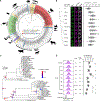Functional differences between rodent and human PD-1 linked to evolutionary divergence
- PMID: 39752535
- PMCID: PMC11774210
- DOI: 10.1126/sciimmunol.ads6295
Functional differences between rodent and human PD-1 linked to evolutionary divergence
Abstract
Mechanistic understanding of the inhibitory immunoreceptor PD-1 is largely based on mouse models, but human and mouse PD-1 share only 59.6% amino acid identity. Here, we found that human PD-1 is more inhibitory than mouse PD-1, owing to stronger interactions with the ligands PD-L1 and PD-L2 and more efficient recruitment of the effector phosphatase Shp2. In a mouse melanoma model with adoptively transferred T cells, humanization of a PD-1 intracellular domain disrupted the antitumor activity of CD8+ T cells and increased the magnitude of anti-PD-1 response. We identified a motif highly conserved across vertebrate PD-1 orthologs, absent in rodents, as a key determinant for differential Shp2 recruitment. Evolutionary analysis suggested that PD-1 underwent a rodent lineage-specific functional attenuation during evolution. Together, our study uncovers species-specific features of the PD-1 pathway, with implications for PD-1 evolution and differential anti-PD-(L)1 responses in mouse models and human patients.
Conflict of interest statement
Competing interests:
E.H. consults for Tentarix Biotherapeutics. The other authors declare that they have no competing interests. J.D.B. consults for Valora and DrKumo and serves as Chief Scientific Officer for Paramita Therapeutics and Pathfinder.
Figures






References
-
- Dong H, Strome SE, Salomao DR, Tamura H, Hirano F, Flies DB, Roche PC, Lu J, Zhu G, Tamada K, Lennon VA, Celis E, Chen L, Tumor-associated B7-H1 promotes T-cell apoptosis: a potential mechanism of immune evasion. Nat Med 8, 793–800 (2002). - PubMed
-
- Sharpe AH, Wherry EJ, Ahmed R, Freeman GJ, The function of programmed cell death 1 and its ligands in regulating autoimmunity and infection. Nat Immunol 8, 239–245 (2007). - PubMed
-
- Chen L, Co-inhibitory molecules of the B7-CD28 family in the control of T-cell immunity. Nat Rev Immunol 4, 336–347 (2004). - PubMed
Publication types
MeSH terms
Substances
Grants and funding
LinkOut - more resources
Full Text Sources
Molecular Biology Databases
Research Materials

